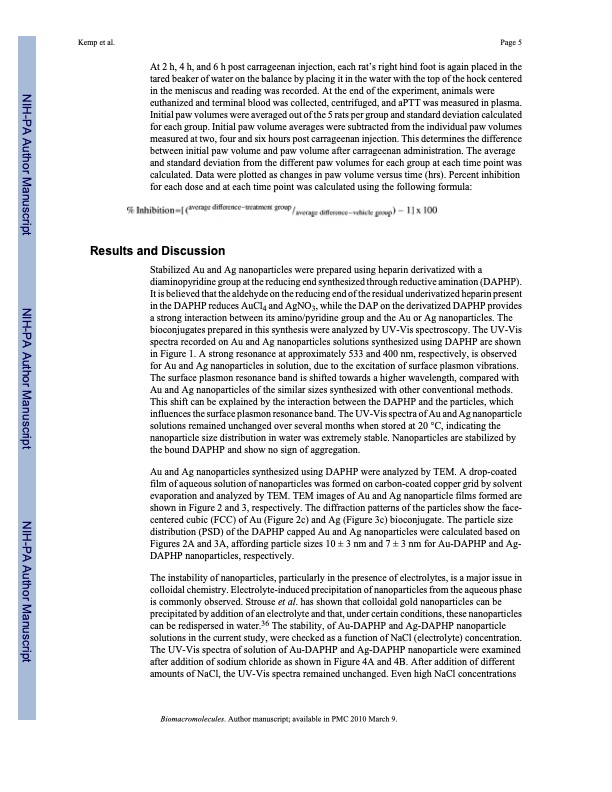
PDF Publication Title:
Text from PDF Page: 005
Kemp et al. Page 5 At 2 h, 4 h, and 6 h post carrageenan injection, each rat’s right hind foot is again placed in the tared beaker of water on the balance by placing it in the water with the top of the hock centered in the meniscus and reading was recorded. At the end of the experiment, animals were euthanized and terminal blood was collected, centrifuged, and aPTT was measured in plasma. Initial paw volumes were averaged out of the 5 rats per group and standard deviation calculated for each group. Initial paw volume averages were subtracted from the individual paw volumes measured at two, four and six hours post carrageenan injection. This determines the difference between initial paw volume and paw volume after carrageenan administration. The average and standard deviation from the different paw volumes for each group at each time point was calculated. Data were plotted as changes in paw volume versus time (hrs). Percent inhibition for each dose and at each time point was calculated using the following formula: Results and Discussion Stabilized Au and Ag nanoparticles were prepared using heparin derivatized with a diaminopyridine group at the reducing end synthesized through reductive amination (DAPHP). It is believed that the aldehyde on the reducing end of the residual underivatized heparin present in the DAPHP reduces AuCl4 and AgNO3, while the DAP on the derivatized DAPHP provides a strong interaction between its amino/pyridine group and the Au or Ag nanoparticles. The bioconjugates prepared in this synthesis were analyzed by UV-Vis spectroscopy. The UV-Vis spectra recorded on Au and Ag nanoparticles solutions synthesized using DAPHP are shown in Figure 1. A strong resonance at approximately 533 and 400 nm, respectively, is observed for Au and Ag nanoparticles in solution, due to the excitation of surface plasmon vibrations. The surface plasmon resonance band is shifted towards a higher wavelength, compared with Au and Ag nanoparticles of the similar sizes synthesized with other conventional methods. This shift can be explained by the interaction between the DAPHP and the particles, which influences the surface plasmon resonance band. The UV-Vis spectra of Au and Ag nanoparticle solutions remained unchanged over several months when stored at 20 °C, indicating the nanoparticle size distribution in water was extremely stable. Nanoparticles are stabilized by the bound DAPHP and show no sign of aggregation. Au and Ag nanoparticles synthesized using DAPHP were analyzed by TEM. A drop-coated film of aqueous solution of nanoparticles was formed on carbon-coated copper grid by solvent evaporation and analyzed by TEM. TEM images of Au and Ag nanoparticle films formed are shown in Figure 2 and 3, respectively. The diffraction patterns of the particles show the face- centered cubic (FCC) of Au (Figure 2c) and Ag (Figure 3c) bioconjugate. The particle size distribution (PSD) of the DAPHP capped Au and Ag nanoparticles were calculated based on Figures 2A and 3A, affording particle sizes 10 ± 3 nm and 7 ± 3 nm for Au-DAPHP and Ag- DAPHP nanoparticles, respectively. The instability of nanoparticles, particularly in the presence of electrolytes, is a major issue in colloidal chemistry. Electrolyte-induced precipitation of nanoparticles from the aqueous phase is commonly observed. Strouse et al. has shown that colloidal gold nanoparticles can be precipitated by addition of an electrolyte and that, under certain conditions, these nanoparticles can be redispersed in water.36 The stability, of Au-DAPHP and Ag-DAPHP nanoparticle solutions in the current study, were checked as a function of NaCl (electrolyte) concentration. The UV-Vis spectra of solution of Au-DAPHP and Ag-DAPHP nanoparticle were examined after addition of sodium chloride as shown in Figure 4A and 4B. After addition of different amounts of NaCl, the UV-Vis spectra remained unchanged. Even high NaCl concentrations Biomacromolecules. Author manuscript; available in PMC 2010 March 9. NIH-PA Author Manuscript NIH-PA Author Manuscript NIH-PA Author ManuscriptPDF Image | Gold and Silver Nanoparticles Stabilized Glycosaminoglycans

PDF Search Title:
Gold and Silver Nanoparticles Stabilized GlycosaminoglycansOriginal File Name Searched:
nihms96339.pdfDIY PDF Search: Google It | Yahoo | Bing
Turbine and System Plans CAD CAM: Special for this month, any plans are $10,000 for complete Cad/Cam blueprints. License is for one build. Try before you buy a production license. More Info
Waste Heat Power Technology: Organic Rankine Cycle uses waste heat to make electricity, shaft horsepower and cooling. More Info
All Turbine and System Products: Infinity Turbine ORD systems, turbine generator sets, build plans and more to use your waste heat from 30C to 100C. More Info
CO2 Phase Change Demonstrator: CO2 goes supercritical at 30 C. This is a experimental platform which you can use to demonstrate phase change with low heat. Includes integration area for small CO2 turbine, static generator, and more. This can also be used for a GTL Gas to Liquids experimental platform. More Info
Introducing the Infinity Turbine Products Infinity Turbine develops and builds systems for making power from waste heat. It also is working on innovative strategies for storing, making, and deploying energy. More Info
Need Strategy? Use our Consulting and analyst services Infinity Turbine LLC is pleased to announce its consulting and analyst services. We have worked in the renewable energy industry as a researcher, developing sales and markets, along with may inventions and innovations. More Info
Made in USA with Global Energy Millennial Web Engine These pages were made with the Global Energy Web PDF Engine using Filemaker (Claris) software.
Infinity Turbine Developing Spinning Disc Reactor SDR or Spinning Disc Reactors reduce processing time for liquid production of Silver Nanoparticles.
| CONTACT TEL: 608-238-6001 Email: greg@infinityturbine.com | RSS | AMP |